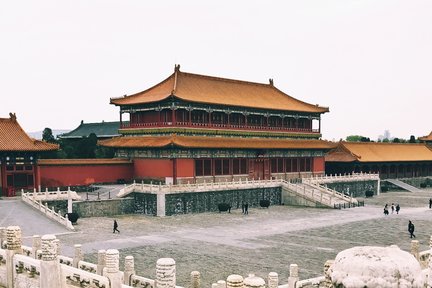Forbidden City

The best of Forbidden City
Bucket-list experiences
Make it a getaway
Trouble-free transport
Why people love Forbidden City
Nearby places to go
FAQs about Forbidden City
When is the best time to visit the Forbidden City in Beijing?
How can I get to the Forbidden City using public transportation?
Do I need to buy tickets in advance for the Forbidden City?
Are guided tours available at the Forbidden City?
What local cuisine should I try near the Forbidden City?
What are the operating hours of the Forbidden City?
What are the best times to visit the Forbidden City to avoid large crowds?
How can I book tickets for the Forbidden City?
Is there a place to eat inside the Forbidden City?
What to know before visiting Forbidden City
Remarkable Landmarks and Must-Visit Sights
Hall of Supreme Harmony
The largest and most significant hall in the Forbidden City, used for major ceremonial events such as enthronements and imperial weddings. It features an intricate caisson ceiling with a coiled dragon and the Xuanyuan Mirror.
Imperial Garden
A compact yet elaborate garden located at the northern end of the Forbidden City, featuring beautiful landscaping, ancient trees, and traditional Chinese architecture.
Palace of Heavenly Purity
Originally the residence of the emperor, this double-eaved building later became the emperor's audience hall. It is connected to the Gate of Heavenly Purity by a raised walkway.
Culture and History
The Forbidden City served as the home of Chinese emperors and the political center of the Chinese government for over 500 years. It was constructed from 1406 to 1420 and has been a public museum since 1925. The palace complex exemplifies traditional Chinese palatial architecture and has influenced cultural and architectural developments in East Asia.
Local Cuisine
While exploring the Forbidden City, travelers can indulge in Beijing's local cuisine. Must-try dishes include Peking Duck, a crispy and flavorful roasted duck dish, and Jiaozi, traditional Chinese dumplings filled with various ingredients.
Cultural and Historical Significance
The Forbidden City served as the political and ritual center of China for over 500 years. It was home to 24 emperors from the Ming and Qing dynasties and remains a vital cultural heritage site.
Architectural Marvel
The layout and design of the Forbidden City reflect Confucian ideals and cosmic order. Its structures were built according to the 'Treatise on Architectural Methods or State Building Standards,' ensuring a hierarchy in design.
UNESCO World Heritage Site
Recognized for its cultural and historical importance, the Forbidden City was declared a World Heritage Site by UNESCO in 1987.
Public and Private Life
The Forbidden City is divided into the outer court, used for state affairs, and the inner court, which was the domestic space for the imperial family. This division highlights the clear separation between public and private life in imperial China.
Ongoing Preservation
As a modern museum and historical site, the Forbidden City continues to undergo renovations and restorations to preserve its structures and artifacts, offering visitors a well-maintained glimpse into China's imperial past.



